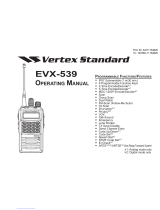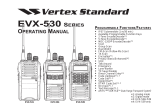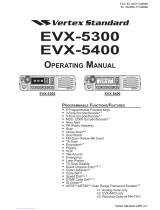Vertex evx-539 User manual
- Category
- Two-way radios
- Type
- User manual
This manual is also suitable for
Vertex evx-539 is a VHF Digital/Analog Transceiver that provides users with reliable and efficient communication. With its advanced features and capabilities, it is suitable for a wide range of professional and recreational applications.
Vertex evx-539 operates in the VHF frequency range of 136-174 MHz and offers a total of 512 channels organized into 32 groups, allowing users to easily access and manage a large number of communication channels. The transceiver supports both analog and digital modes, including 16K0F3E/11K0F3E for analog and 7K60F1E/7K60FXE for digital (12.5 kHz Voice), providing users with the flexibility to communicate in different environments and with various types of equipment.
Vertex evx-539 is a VHF Digital/Analog Transceiver that provides users with reliable and efficient communication. With its advanced features and capabilities, it is suitable for a wide range of professional and recreational applications.
Vertex evx-539 operates in the VHF frequency range of 136-174 MHz and offers a total of 512 channels organized into 32 groups, allowing users to easily access and manage a large number of communication channels. The transceiver supports both analog and digital modes, including 16K0F3E/11K0F3E for analog and 7K60F1E/7K60FXE for digital (12.5 kHz Voice), providing users with the flexibility to communicate in different environments and with various types of equipment.




















-
 1
1
-
 2
2
-
 3
3
-
 4
4
-
 5
5
-
 6
6
-
 7
7
-
 8
8
-
 9
9
-
 10
10
-
 11
11
-
 12
12
-
 13
13
-
 14
14
-
 15
15
-
 16
16
-
 17
17
-
 18
18
-
 19
19
-
 20
20
-
 21
21
-
 22
22
-
 23
23
-
 24
24
-
 25
25
Vertex evx-539 User manual
- Category
- Two-way radios
- Type
- User manual
- This manual is also suitable for
Vertex evx-539 is a VHF Digital/Analog Transceiver that provides users with reliable and efficient communication. With its advanced features and capabilities, it is suitable for a wide range of professional and recreational applications.
Vertex evx-539 operates in the VHF frequency range of 136-174 MHz and offers a total of 512 channels organized into 32 groups, allowing users to easily access and manage a large number of communication channels. The transceiver supports both analog and digital modes, including 16K0F3E/11K0F3E for analog and 7K60F1E/7K60FXE for digital (12.5 kHz Voice), providing users with the flexibility to communicate in different environments and with various types of equipment.
Ask a question and I''ll find the answer in the document
Finding information in a document is now easier with AI
Related papers
-
Vertex EVX-531 User manual
-
Vertex SD995 Installation guide
-
Vertex FIF-12 User manual
-
Vertex VX-210AV User manual
-
Vertex VX-820 series User manual
-
Vertex VX-264 User manual
-
Vertex VX-5500 Operating instructions
-
Vertex VX-2200 Series User manual
-
Vertex VX-230 Series User manual
-
Vertex VX-180EU User manual
Other documents
-
 Vertex Standard USA evx-539 User manual
Vertex Standard USA evx-539 User manual
-
Vertex Standard VX-231 Owner's manual
-
Vertex Standard VX-350 series User manual
-
 Motorola Solutions EVX-530 User guide
Motorola Solutions EVX-530 User guide
-
YAESU MD-200A8X Technical Supplement
-
 Vertex Standard USA AXI11144640 User manual
Vertex Standard USA AXI11144640 User manual
-
Vertex Standard EVX-531 Operating instructions
-
Standard Horizon HX370SAS User manual
-
Vertex Standard VX-2500V User manual
-
Vertex Standard VX-230 Series User manual



























